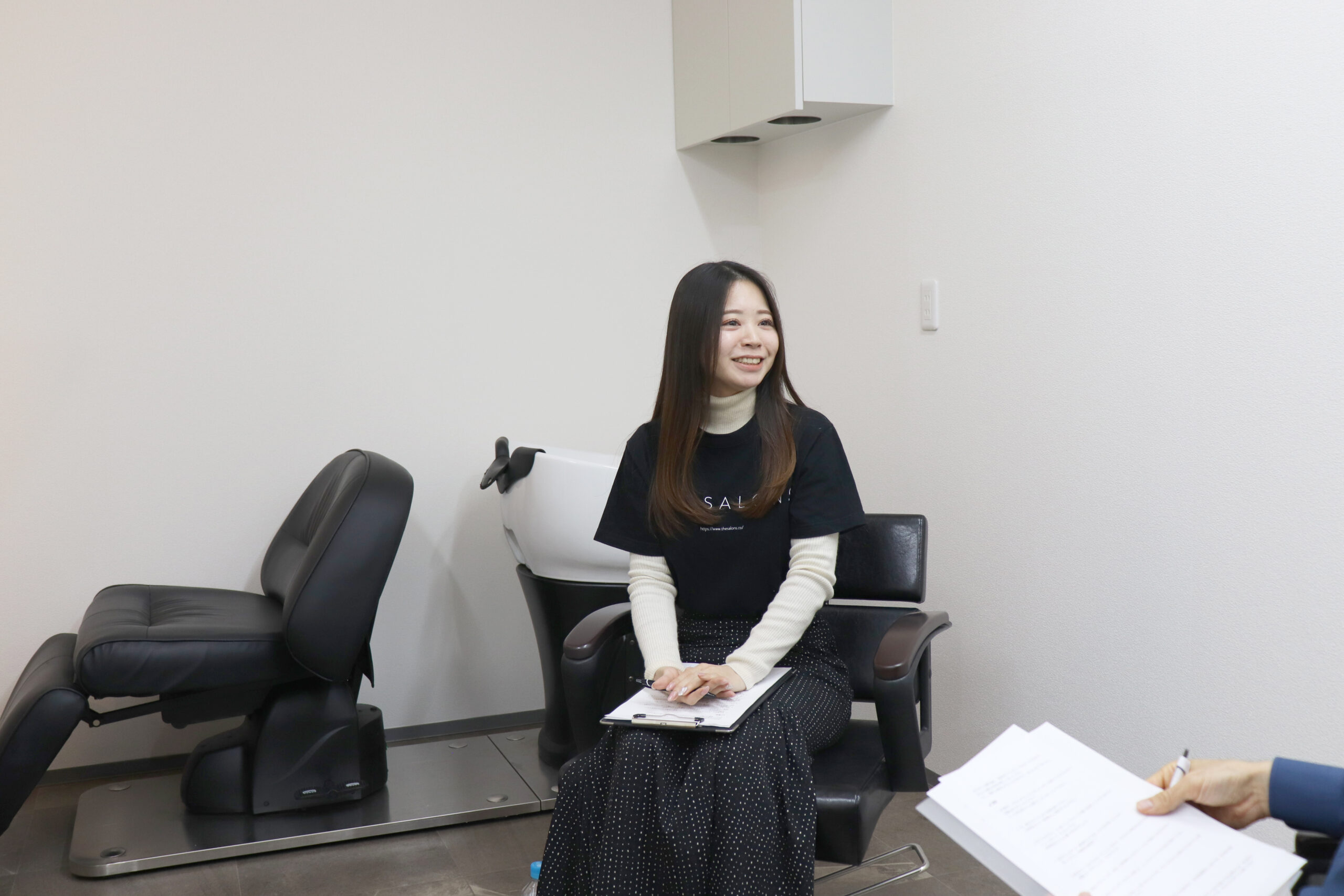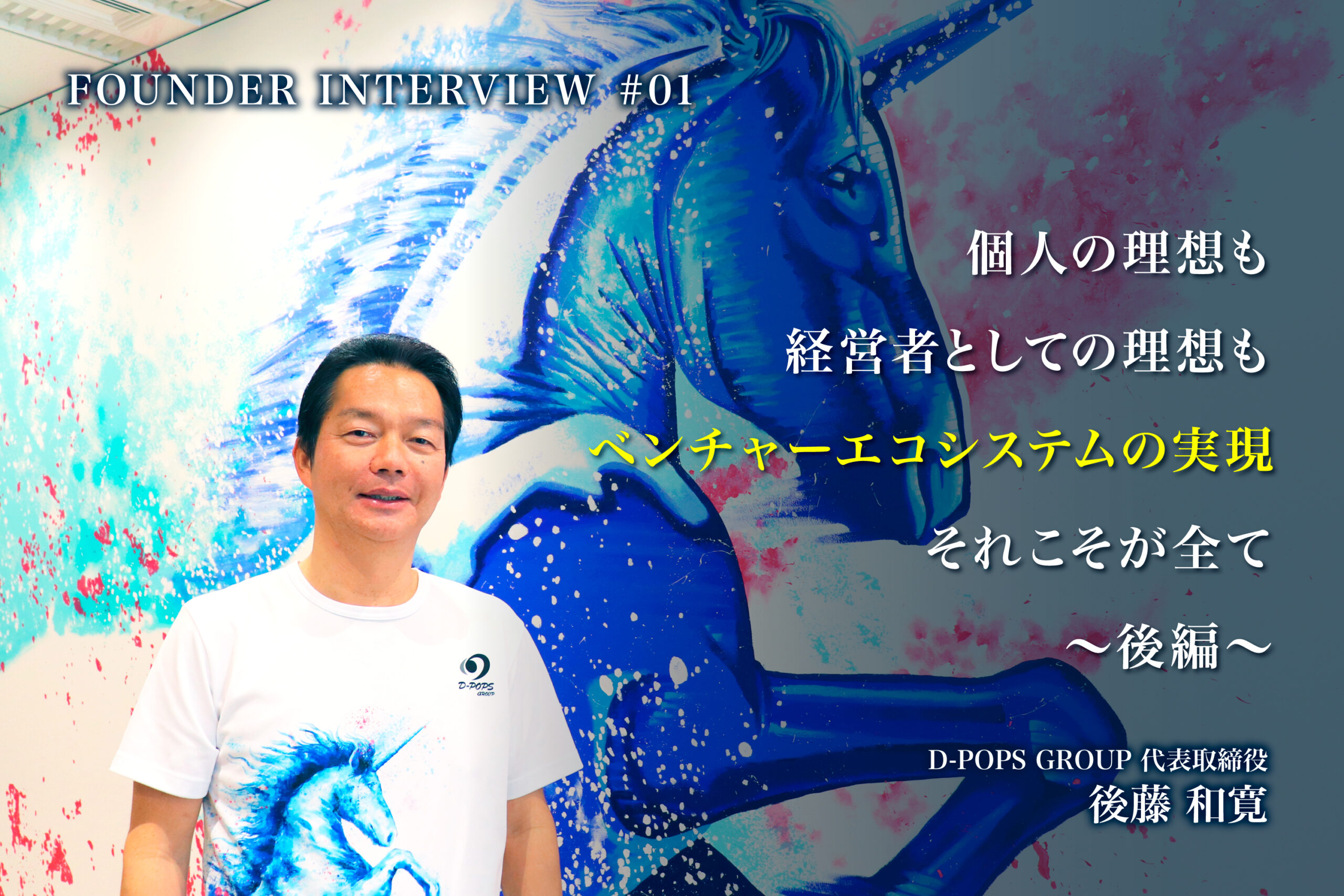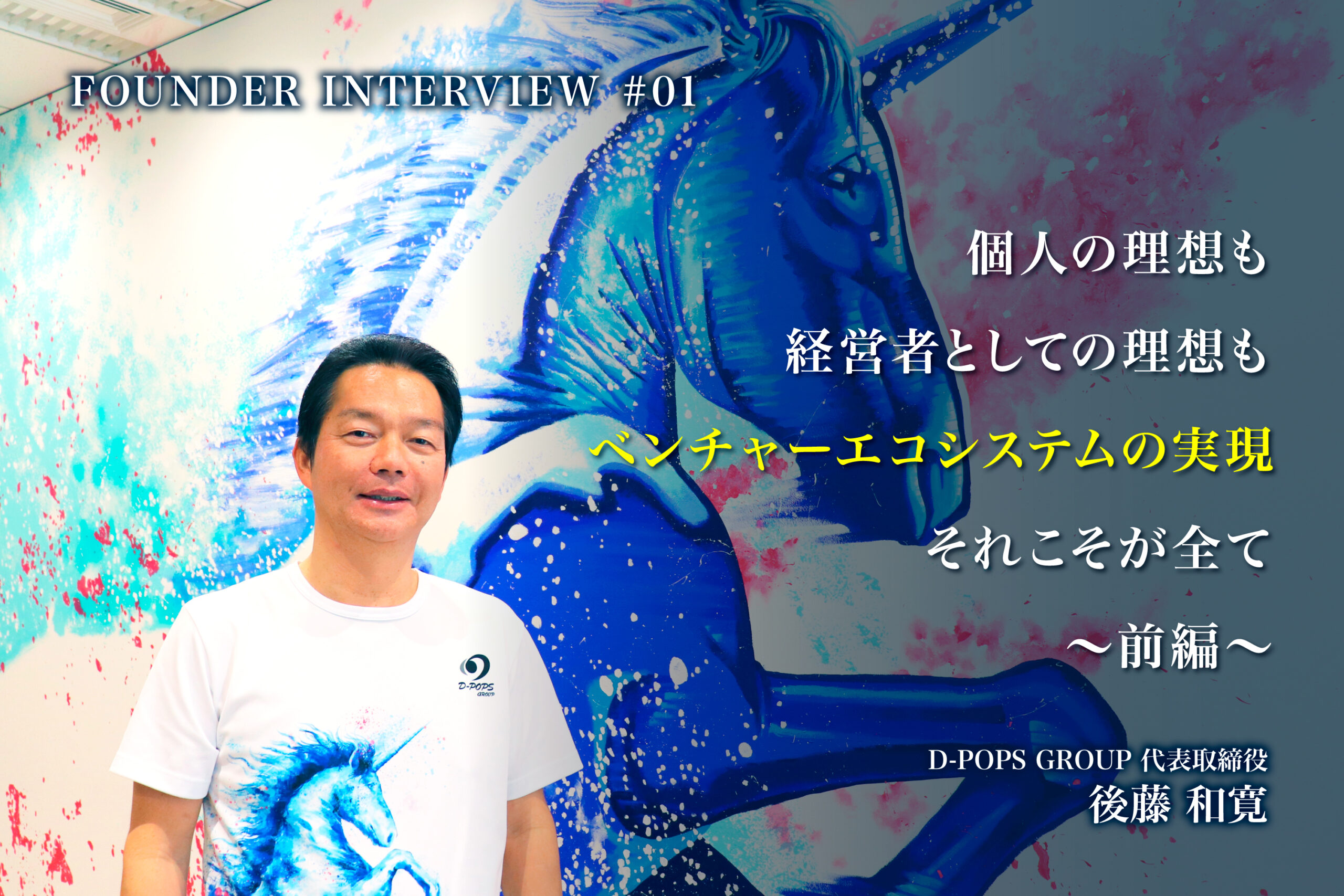
Aiming to Improve Services to Solve Problems in the Beauty Industry While Supporting Two Founders
Last year, our company entered into a strategic capital and business alliance with The Salons Japan, Inc., which leases private salon studios for professional beauticians, and we began our journey together as partners in the Venture Ecosystem.
☆You can see the press release regarding this strategic capital and business alliance with The Salons Japan Inc. on the following page:
https://d-pops-group.co.jp/en/column/the-salons-japan/
For this article, we interviewed Yume Oki, the first employee at The Salons Japan supporting the company’s two founders. (This interview was conducted in January 2025.)
◆The Path to Joining the Company
Sugihara:
Today, we are interviewing Yume Oki, The Salons Japan’s first employee. Thank you for your time. To start, could you tell us about how you came to join The Salons Japan?
Oki:
The first member I met was Director Kuboshima. I had previously worked as a receptionist at a hair salon. Knowing my background, Director Kuboshima told me, “Actually, we have a private salon studio leasing business at our company, The Salons Japan.” I felt that this beauty mall service could solve the issues I had felt were a problem when I was working at the salon reception. Because of that, I became very interested in The Salons Japan and hoped to join the company.
Sugihara:
When did that happen?
Oki:
I first met him in 2019, and I joined in April 2020. It was right at the start of the COVID-19 pandemic.
Sugihara:
The Salons Japan was established in November 2018, and the first location opened in 2019, so you became the first employee following the two founders. Could you tell us about your current role at The Salons Japan?
Oki:
My main duties are handling inquiries from beauty professionals and managing the facility viewings that accompany them. I conduct the viewings together with President Shimizu, our CEO, and arrange the procedures up to the application and contract stages.
I also handle various arrangements for new store openings, contract writing, and tasks related to facility management, such as setting up communication devices. I also handle correspondence with external vendors and take care of troubleshooting.
Sugihara:
So, you also manage contracts! I would assume the number of tenants moving in is high, but just how many contracts have you prepared at this point?
Oki:
Yeah…I can’t even count them, ha ha. Initially, I had no knowledge of contracts or real estate, but for contracts related to our company, I can now explain the important points written in them. I prioritize communication most highly in my work. Not just day-to-day communication, I make sure to properly convey important things while empathizing with the other person’s feelings.
This is where my previous experience as a salon receptionist truly comes into play—making sure communication isn’t one-sided and staying close to the other person’s feelings. Since my reception work included customer support and handling complaints, I value using feedback to solve problems, as this is a step towards continuous improvement.
Sugihara:
That’s wonderful. Do you feel that experience in the beauty industry is necessary to handle contracts and viewings for THE SALONS?
Oki:
Yes, I think it might be smoother for someone who has been involved in the beauty industry compared to someone who has experience in real estate.
However, this is also the most frustrating part for me: while I have been involved in the beauty industry, I am not a practitioner myself. When I meet beauty professionals, I feel there is a mutual understanding that exists only between them. Sometimes, when a viewing progresses quickly, I get asked, “Are you a beauty professional?” Every time that happens, I get this mild sense of regret that things would be even better if I were one.
After all, during viewings President Shimizu often says, “I’m a beauty professional too!”, ha ha.

◆The Difference Between THE SALONS and the Shared Salon Model
Sugihara:
Now, we hear the term “shared salon” quite frequently. But could you explain how THE SALONS is different from a shared salon?
Oki:
Certainly. The clearest difference is that while typical shared salons offer only chairs or semi-private spaces for rent, THE SALONS provides fully-partitioned individual units that can be used in the same way a business owner can use a street-facing storefront.
With the chair rental model I just mentioned, even though the entire floor is rented by the operating company (as is the case for THE SALONS), the control of all sales and operations is tied to the owner that rents to the beauty professionals.
However, at all THE SALONS locations, we obtain permission from the building owners to treat each private studio like a separate salon. Therefore, the biggest difference is that our clients can operate as if they owned their own shops, and build track records as business owners even though they’re renting private rooms.
Sugihara:
So, they can truly become the owner of their own shop. In that case, I guess there are beauty professionals who choose THE SALONS after comparing with shared salons?
Oki:
Yes, absolutely. And quite a few people switch to THE SALONS from shared salons, as well. We also think there must be some professionals who wish to be independent but can’t immediately afford to move into THE SALONS.
We now offer many plans to lower the barrier slightly. However, the people who are not fully decided are probably more interested in hearing “By becoming independent at a shared salon or chair rental space, you can increase your salary” than “You can have your own shop.”
However, I get the idea that those who consider both and ultimately choose THE SALONS are often those who eventually want to open a ground-level shop.
Sugihara:
I haven’t seen any advertising put on the outside of THE SALONS’ private studios. Is this because most of the salon owners’ clients are already fixed?
Oki:
Basically, yes. While some are aiming to attract new customers, the overwhelming majority of salon owners already have a secure client base. To explain why, I’ll use the shared salon model as an example for comparison. Shared salons take a percentage of sales, and seat usage fees are in the tens of thousands of yen.
If a stylist makes ¥500,000 in monthly sales, their payment might be 10% (¥50,000) plus the seat usage fee. In our THE SALONS model, the cost to rent a space is around ¥300,000 to ¥400,000 per month. This amount is difficult to afford for those who don’t have established sales. Therefore, when they consider their revenue, my impression is that most have the confidence that their customers will reliably follow them.
◆Characteristics of THE SALONS Studio Renters
Sugihara:
What kind of people are most of THE SALONS studio renters?
Oki:
Beauty professionals generally have an intense desire for improvement, and my overall impression is that most of them have very strong personal preferences. However, there are surprisingly few clashes or facility-related troubles between them. To help prevent such issues, we set a rule that price lists and menu displays are not to be shown on the outside of our salon studios.
Also, since our salon studios are private, most are operated by appointment only, and the customers go directly to the studio where their reservations are. Given that, I don’t think customers typically wander around inside of THE SALONS checking out all of the different studio spaces. As a result, there is no competition between our salon studio renters for customers nor for staff.
Sugihara:
Are there any success stories of beauty professionals who went from ordinary employees to becoming salon owners after moving into THE SALONS?
Oki:
Yes, there are! Salaries in the beauty industry are expected to be low. Working hours are long even though the pay and benefits aren’t great, and it takes a long time to become a full-fledged beauty professional. But one individual, after having worked under those conditions for a long time, joined THE SALONS and received a sevenfold increase in income.
Sugihara:
A sevenfold increase in income?! That’s incredible!!
Oki:
It is! I was truly shocked when I heard that. Of course, I couldn’t ask for details about the person’s previous salary, but the fact that it increased sevenfold was one surprising thing, and it also left me thinking that if such growth is possible, the potential for THE SALONS tenants is truly unlimited.
Also, the use of THE SALONS spaces is varied. One salon started with a single studio space, but their sales grew faster than expected, so they hired employees and decided to rent the neighboring spaces. In the end, they expanded to a total of four studios.
Oh! And this is a super heartwarming story, but there was a lead salon owner and an assistant who rented a studio together. They both increased their sales, and the assistant eventually “graduated” and began to rent a separate studio.
The fact that someone who started out in THE SALONS chose to rent another of our studios even after attaining independence showed that they thought highly of THE SALONS’ service, which made me very happy.
Sugihara:
So, what this means from a beauty professional’s perspective is this. In the shared salon model, payments to a shared salon owner increase proportionally as sales increase, while payments to THE SALONS are fixed, so anything above those fixed costs becomes capital for their own salon. In that respect, they are truly the owners of their own business. Speaking of which, are all your tenants able to handle the business management aspect of things?
Oki:
Business management is what everyone worries about most, at first. When giving facility tours, we meet a lot of people who say, “I don’t know anything about running a business.” However, since it essentially becomes their own salon, they have to learn as they go. Of course, if they do have questions, our company is happy to provide support.
Now, one impressive thing about beauty professionals is how many of them are truly dedicated to learning. Some consult with tax accountants on their own, while others start by figuring it out themselves and then hire tax accountants when they incorporate their businesses.
Sugihara:
Does THE SALONS provide services to tenants for introducing tax accountants and such?
Oki:
Yes, we do. Tax accountants offer their services at a special rate for THE SALONS members. As for social insurance consultants and lawyers, in case our tenants have any issues or troubles, we are connected with individuals who are available for consultation. However, this is not a package deal…we can introduce them to lawyers and consultants who are familiar with THE SALONS’ services, but the contract is directly between them and the professional.
Sugihara:
President Shimizu once told me a story about a very popular salon owner who kept money in a cardboard box for a while after moving in, ha ha.
Oki:
Ha! Yeah, we do have people like that. When they first open their salons, they have so much to do that they get overwhelmed and lose their composure.
Along those lines, the rent at THE SALONS includes utilities. I think people who are busy might forget to pay if they have too many bills, so we hope this arrangement reduces the hassle of payments. Some tenants really are that crazy busy at the start.

◆Characteristics of THE SALONS Facilities
Sugihara:
I’m sure it would be helpful to have a single, all-inclusive payment like that.
Now, to change the subject, THE SALONS had opened a total of seven locations until last year. Do they each have a unique characteristic?
Oki:
First, we have one consistent, overall design concept: not to upstage the individual salons. From a stylistic standpoint, the common areas tend to be simple rather than overly extravagant, so that they won’t offend most people’s tastes.
However, while the Omotesando location was initially founded on a really simple white design, it has gradually evolved. President Shimizu often talks about a “New Vintage” or American hotel style, so while we stayed out of the way of the salon studios, we upgraded the design of the common areas by trying to add light gray tones to make them more satisfying.
Also, at the Harajuku Cat Street location, we upgraded the space by addressing two issues that were brought to our attention. Since THE SALONS houses many individual salons, many people walk through the common areas, and the sound of footsteps is sometimes bothersome. So, starting with the Harajuku Cat Street location, we’ve been installing carpet tiles to dampen the sound. Secondly, since pure white floors show dirt easily, we’ve been changing to a slightly darker color. These improvements from previous locations are used to upgrade other locations in the future.
Then there's atmosphere. The Aoyama location is below the ground level, so we added extra lighting to make it feel less subterranean, and we utilized the existing steel doors to create a somewhat warehouse-like ambiance. It’s full of President Shimizu’s distinct personal touch.
For the Harajuku Cat Street location, President Shimizu started to entrust some of the decision-making to me. I got to help choose materials for the flooring and other things! And for the Shinjuku location opening this month, we decided on everything together with the new members who joined the team.
Sugihara:
With eight locations just in Tokyo currently, do the beauty professionals at each location have any distinctive characteristics?
Oki:
In the case of the Harajuku Cat Street location, the Harajuku area has tons of salons that specialize in bleaching and dyeing hair, so most of our tenants in that location focus on bleach and high-tone hair dyeing. Also, their customers as well as the stylists themselves are often younger in age.
By contrast, at our Ginza location, the age range of both customers and professionals is greater, and there are many high-priced salons focusing on hair-quality improvement and straightening.
At the Kichijoji location, which is a bit more suburban, there are many community-focused salon owners. Many of their clients apparently live nearby, and all of the beauty professionals there say they want to continue working in Kichijoji. I feel that many of them put a high value on creating an at-home atmosphere.
Sugihara:
What is the occupancy status of your locations?
Oki:
Almost all locations are fully booked. Currently (as of January 2025), the only studios available for immediate move-in are one at our Aoyama location and two at our Harajuku location.
The Kichijoji location is completely full, and yet there are people who come for viewings who tell us, “We want to move in as soon as someone leaves”, which makes us feel very grateful.

◆ Challenges and Sense of Fulfillment
Sugihara:
After working here for the past five years, do you want to share any stories about challenges you faced or satisfying moments?
Oki:
One big challenge was when we were getting ready to open our Aoyama location, and the communication equipment shipment was delayed. We had placed the order, but due to the global semiconductor shortage, we were told the equipment wouldn’t arrive on time…
Since the Aoyama location has a basement floor, nothing could be done there without a Wi-Fi connection. The time when we had to rely on pocket Wi-Fi was the biggest pinch. Because they were small devices, they would overheat when everyone was using them. So, we placed fans in front of the machines to cool them down, and in order not to overuse them, we used every other trick in the book before connecting to them.
Having no internet meant our tenants couldn’t take appointments, they had no way to process their sales, and they couldn’t receive contact from their customers, so it really was a terrible time.
As for moments of satisfaction, in addition to the story I shared about the sevenfold income increase, I occasionally get to hear stories from people whose working environment has improved. For example, being able to take days off on weekends and holidays.
In an ordinary salon, the days when the average working person is free are the busiest days. However, since their loyal customers will come on whatever days the salon owners designate, their clients are understanding of them taking weekends off, and I’m always very happy to hear how they can finally go traveling and stuff.
Also, at one of our THE SALONS location’s year-end parties, I heard one of the beauty professionals say, “I’m so glad I moved in!” I was so touched that I even cried a little. I felt incredibly happy to realize that we have created a service that can truly change a tenant’s life.
On a personal note, securing a salon studio contract on my own was a huge moment. It felt like my efforts had helped an individual to imagine the future and solve problems, so that was also a source of fulfillment.
Interview conducted by D-POPS GROUP’s advisor Genta Sugihara.
The Salons Japan
Company President and CEO: Hidetoshi Shimizu
Address: 2F Kid Ailack Building, 2-43-11 Matsubara, Setagaya-ku, Tokyo
Established: November 30, 2018
Website: https://www.thesalons.co/
Next, in the latter part of the interview, we discuss:
・Changes since the company’s founding
・Changes after the strategic capital and business alliance
・The founders, President Shimizu and Director Kuboshima
・The status of new store openings
・“Realizing a Venture Ecosystem”
・And other topics
Be sure to check it out here:
https://d-pops-group.co.jp/en/column/the-salons-japan-interview2-latter-part/






